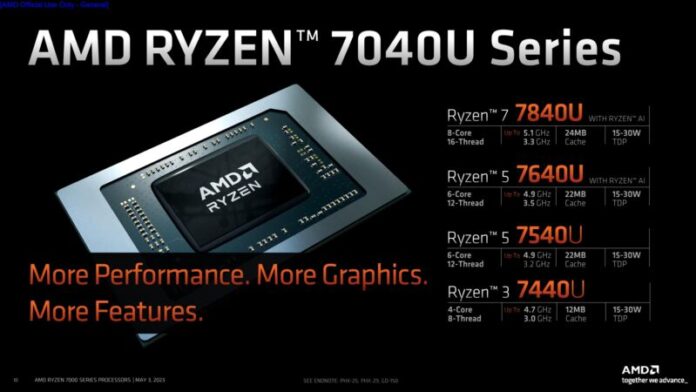Today AMD announced additional details about its new Ryzen 7040U series of laptop chips, which bring the company’s newest Zen 4 CPU architecture and RDNA 3 integrated graphics into thin-and-light laptops. Though just part of AMD’s (often-confusing) Ryzen 7000 laptop lineup, the 7040U processors will be the ones to hold out for if you want to maximize performance without stepping up to a larger laptop with a dedicated GPU.
AMD has delayed the announcement of these chips twice. AMD announced in mid-March that systems would begin shipping in April, and it’s currently the beginning of May. One of the laptop makers offering a Ryzen 7040-series laptop, Framework, won’t actually be shipping its preorders until sometime in Q3, though the larger PC companies will presumably be able to get things to market a bit sooner.
For most apps and games, the most relevant thing about the Ryzen 7040 chips is the improved CPU and GPU performance. The top-end Ryzen 7 7840U combines 8 CPU cores running at speeds of up to 5.1 GHz and a Radeon 780M GPU with 12 RDNA 3 cores. The Ryzen 5 7640U has 6 CPU cores running at up to 4.9 GHz and a Radeon 760M GPU with 8 cores. The Ryzen 5 7540U has the same 6 CPU cores but with a lower-end Radeon 740M GPU with 4 cores, while the Ryzen 3 7440U combines the same Radeon 740M GPU with 4 CPU cores.
All four CPUs have a TDP of between 15 and 30 W. Manufacturers can decide what TDP they want to use based on how fast they want their computers to be and how much heat their fans and heatsinks are capable of dissipating.
The 7840U and 7540U look an awful lot like the Ryzen Z1 Extreme and Z1 processors that AMD announced for handheld gaming PCs last week, and from that announcement, we know that stepping up from 4 to 12 GPU cores doesn’t necessarily triple or even double your performance. Memory bandwidth is still a major limitation for integrated GPUs, so even the low-end Radeon 740M should be a step up over the three-generation-old Intel Iris Xe GPU that Intel still uses for its ultrabook processors.
The RDNA 3 graphics architecture from the Radeon RX 7900 XT and XTX is also being used for these Radeon 700-series integrated GPUs.
The RDNA 3 graphics architecture from the Radeon RX 7900 XT and XTX is also being used for these Radeon 700-series integrated GPUs.
AMD
Regarding performance, AMD says that the 7840U can beat both the Core i7-1360P and Apple’s M2 in a few broad performance categories. Curiously, the company didn’t compare the 7840U to the Core i7-1370P, which is Intel’s fastest CPU in this product category and has two extra P-cores compared to the i7-1360P. Ryzen’s performance should still be competitive but take AMD’s performance comparisons with a grain of salt.
The 7840U and 7640U also include a new feature called “Ryzen AI,” which, as the name implies, is dedicated hardware for accelerating AI and machine-learning workloads (Apple’s “Neural Engine” fills a similar role in the M1 and M2 chips). Ryzen AI is powered by AMD’s XDNA architecture, a product of AMD’s acquisition of Xilinx. AMD says that Ryzen AI is “the first dedicated artificial intelligence hardware in an x86 processor.” Intel’s next-generation chips, codenamed Meteor Lake, are also said to include AI acceleration, but they won’t be here until later this year at the earliest.
FURTHER READING
“Project Volterra” review: Microsoft’s $600 Arm PC that almost doesn’t suck
Ryzen AI should improve the performance of things like AI-powered language models, image generation, and audio transcription when you’re running those workloads locally instead of relying on a server. Windows 11 has a handful of built-in AI-accelerated features, including “Studio Effects” for webcams that can replace your background and apply other effects. For now, these are mostly exclusive to Arm-based Windows hardware like the Surface Pro 9 with LTE or the Windows Dev Kit 2023, since their Qualcomm Snapdragon-based processors include “neural processing units” (NPUs) that most current x86 processors don’t have.
Windows and other operating systems will presumably begin to add in more AI-powered features as more PCs get the hardware necessary to take advantage of them.








